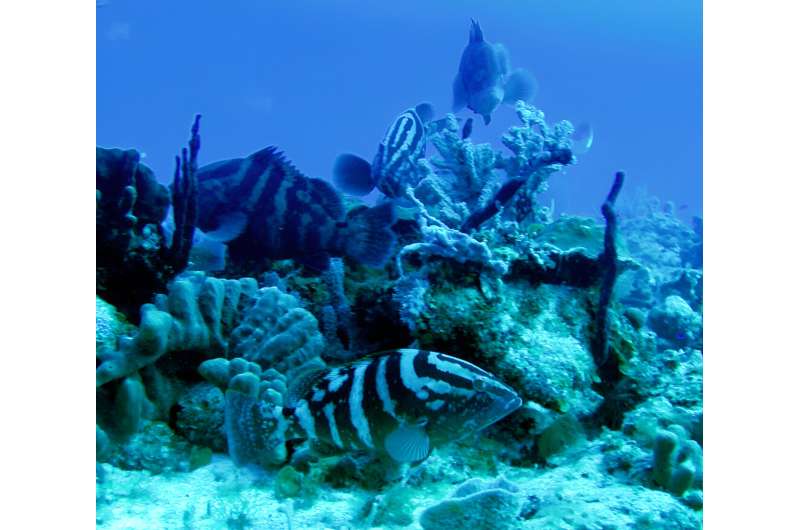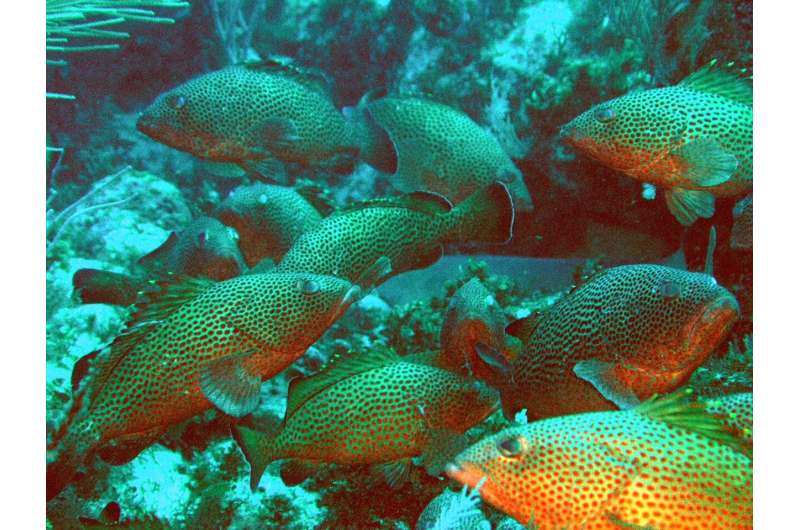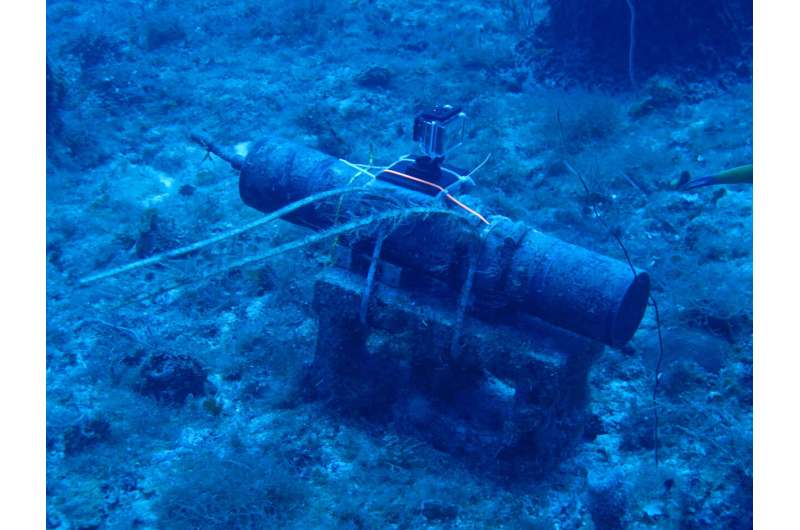This article has been reviewed according to Science X's editorial process and policies. Editors have highlighted the following attributes while ensuring the content's credibility:
fact-checked
peer-reviewed publication
trusted source
proofread
Protected sex: Study records grouper mating calls in marine managed areas

A couple of months each year, groupers (Epinephelidae) gather in the hundreds and even thousands to mate under the full moon. This concentrated nature and short duration of mating, however, renders these species susceptible to incidental fishing and poaching.
Although protective measures are in place through marine managed areas, these management zone boundaries may fail to fully encompass fish migration paths and chronological variability in fish spawning aggregations, especially for threatened species.
Recent evidence suggests that some reproductive times are extending beyond months and locations for which the marine managed areas were established. Yet, impacts of protecting fish spawning aggregations with seasonal marine managed areas or market bans remain largely unknown.
A "call" of the wild inspired researchers from Florida Atlantic University's Harbor Branch Oceanographic Institute to follow and record grouper mating sounds at three marine managed areas off the west coast of Puerto Rico in the United States Caribbean.
For the study, researchers used passive acoustics to locate spawning aggregations of two commercially important species—the Nassau (Epinephelus striatus) and red hind (Epinephelus guttatus) groupers—to determine temporal patterns in their reproductive behaviors as well as habitat use. These marine managed areas have focused on reproductive seasons through seasonal closures.
"Groupers produce very distinct sounds associated with courtship, territoriality or reproduction. Some sounds are species-specific in frequency and pulse rate, which allows their signal to be clearly detected from acoustic recordings," said Laurent Chérubin, Ph.D., senior author and a research professor at FAU Harbor Branch. "These grouper calls are distinctive in duration, peak frequency, and tonal characteristics, and are easily distinguished from each other audibly and visually in spectrograms."
An autonomous mobile wave glider was deployed to survey two marine managed areas on the western shelf of Puerto Rico: Abrir la Sierra and Bajo de Sico. Using hydrophone recorders and a machine-learning fish sound detector and classifier tool called Fish Acoustic Detection Algorithm Research (FADAR), researchers assessed spatial distribution of grouper calls, compared the timing of grouper calls between the fixed recorders and the wave glider and determined the spatiotemporal distribution of the two species as they aggregated to spawn.
The multi-day wave glider mission was designed to repeatedly survey over known sites while also sampling nearby areas that met typical fish spawning aggregations habitat characteristics, namely the shelf edge. The courtship-associated sound detection results were then used to determine hourly and daily call rates for each species. The underwater passive acoustic recorders recorded four minutes of ocean sounds every hour.

Results of the study, published in the journal Fisheries Research, reveal that known fish spawning aggregations sites are critical habitat for both Nassau and red hind species. Moreover, the existence of potential, previously unknown fish spawning aggregations for multiple grouper species also highlights the importance of spatial and temporal expansion of existing regulations.
Researchers found a notable spread of courtship-associated sounds of approximately 500 meters of both spawning aggregation sites, which varied with the moon phase. The presence of multiple, smaller aggregations of red hind within fish spawning aggregations suggest increased spread such as to the southern shelf of the U.S. Virgin Islands.
"The use of fish spawning aggregation sites by multiple species has important implications for management decisions," said Chérubin. "Estimating their relative importance across habitat is needed to understand the population trends and potential for recovery. Fish could be moving from one site to another across spawning seasons because of environmental changes or other local drivers such human presence."

The variability in peak courtship-associated sound timing also suggests temporal variability is operating on sub-regional scales. Expanded or permanent closures of known fish spawning aggregations that include threatened species would accommodate for this variance in timing of aggregations, promoting their recovery.
"Passive acoustic methods do not interfere with grouper reproductive behaviors and may be a cost-effective alternative for managers or researchers monitoring various fish spawning aggregations simultaneously," said Chérubin. "Moving forward, we hope to assess correlations between fish density and courtship-associated sound levels to explore the utility of acoustics as a sole mechanism for future studies, further reducing the effort required to identify and monitor these vulnerable fish spawning aggregations."
More information: Caroline Woodward et al, Spatial distribution of spawning groupers on a Caribbean reef from an autonomous surface platform, Fisheries Research (2023). DOI: 10.1016/j.fishres.2023.106794
Journal information: Fisheries Research
Provided by Florida Atlantic University
















